2003 Dodge Dakota Rear End Noise When Backing
"The rear differential plays a very large role in the working assembly of a car, truck or semi. We all know that a vehicle works via its engine's piston motion which is powered by fuel combustion. But how exactly does the motion of the piston or crankshaft convert to the rotational motion of the wheels? Let's take a look at the magic of the rear differential and the problems that arise from rear differential noise."
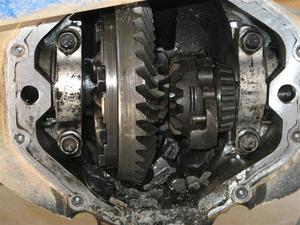 What is the Purpose of a Rear Differential?
What is the Purpose of a Rear Differential?
The differential is the final end mechanism that enables the creation of torque in the crankshaft before it is distributed through the transmission, to the drive shaft, and then to the wheels. This part serves to transmit engine power to the wheels while also enabling them to have different rotation speeds. This very purpose is the reason behind the name 'differential'—because it can distribute different kinds of speeds to wheels especially during a turn.
The pair of driving wheels in a vehicle does not rotate at the same speed during a turn. In situations like this, the wheel on the turning side (inside wheel) rotates slower than its counterpart (outside wheel). This is made possible with the help of the rear differential's side gears and spiders. To put it simply, this mechanism is the one that decides the speed and the frequency of the turning of the axle and wheels in relation to the turning of the drive shaft. This is often referred to ring and pinion ratio. If for example you have a rear gear ratio of 3.73:1, this simply means that the drive shaft (which is connected directly to the pinion gear) is going to rotate 3.73 times to the wheels turning one, full rotation.
What does the Rear Differential do?
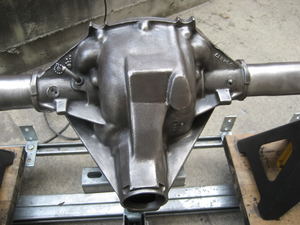 The differential doses the power to the two wheels at the exact proportions and speed to ensure that stability is kept to the maximum and strain on the drivetrain, differential components and tires is kept at a minimum. Two wheels on a drive axle without a differential in the middle would result in both wheels receiving the same power at all times. Having a differential however, enables each wheel to act individually.
The differential doses the power to the two wheels at the exact proportions and speed to ensure that stability is kept to the maximum and strain on the drivetrain, differential components and tires is kept at a minimum. Two wheels on a drive axle without a differential in the middle would result in both wheels receiving the same power at all times. Having a differential however, enables each wheel to act individually.
Why should you care? Well this makes a world of a difference when turning. Simply put, the differential allows each wheel to be independent from the other while still sending power to both of them. When one wheel is spinning slower on a curb, the mechanism will keep driving the other wheel without any skidding, binding or jerking. It the differential would not be present, we would have wheels locked together at the same speed in a turn. This would make turning difficult and with a high probability of losing control.
Besides turning, other issues could arise from the drivetrain as it would be exposed to high forces. What would happen is that one tire would need to grab and slip in order to maintain the same speed as the other one leading to the transmission of the force through the axle to all its components resulting in a huge strain on axle components and tires that leads to premature wear.
What Are The Symptoms of a Bad Rear Differential?
Rear differentials give out noticeable symptoms once they start wearing out or getting damaged. Usually once your differential goes bad you might experience any of the following:
- Difficulty in handling
As the differential is the element which helps handle your vehicle in a turn, once it starts to wear out, precision is not something that will be on your side anymore. The wheels will no be able to readjust their speeds making the handling of your vehicle quite unpredictable and can lead to an accident. It would be advisable to get your car to a mechanic as soon as you sense an issue with handling. - Tire damage
As you take corners the wheels and tires traveling at the same speed will lead to a premature wear of the inner tires or even damage because the speed will be significantly higher than what the inner threads were designed to sustain. - Vibrations
Significant wear and tear done to the universal joints of your differential lead to vibration in the drive shaft. This vibration can be felt more accentuated when you accelerate your vehicle and can lead to even stronger vibrations if differential fluid leak appears. These are early warning signs that the differential needs checking as soon as possible. - Whining Noises
These are the most common and appear due to lack of lubrication over internal components of the differential. This lack of lubrication can appear thanks to leaking fluids for example and will inevitably lead to whining noises when that happens. - Gear Grinding
Hearing an increase in the level of humming noises or gear grinding is a way of knowing almost for sure that you have a worn out differential. Usually the humming gets louder under acceleration. When this occurs it's best to check the condition of your differential and replace if it's in a rough condition.
Rear Differential Noise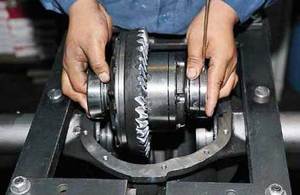
The rear differential is made up of many gears with teeth entwined with each other. The effectiveness of its function is dependent on how precise these gears are arranged and oriented relative to each other. If, for example, lubrication runs low on the mechanism or the arrangement of the gears goes out of place, rear differential noise occurs. Gear whine, bearing noise and clunking are common rear differential noises that should be a concern to vehicle owners.
Rear Differential Noise vs Wheel Bearing Noise
Because bearings are incorporated in each wheel and also in differential, most of the times it's very tricky to discover if the the noise that is produced is a rear differential noise or a wheel bearing noise.
As a bearing begins to wear, friction increases and metal material is worn down making often bad noises until it finally fails. Failing bearings can make whistle noise or a roaring grinding type of noise. Often the noise get louder as the cars speed or load increases.
As often the noise resonates through the chassis, pinpointing the source of it is very difficult. Thankfully there are a few simple things that can help distinguish between rear differential noise and wheel bearing noise.
Wheel Bearing NoiseSimplest check to identify a failing wheel bearing is to suspend the car so that the wheel does not touch the ground. Then grab the wheel and wiggle it back & forth. The hub containing the bearing should not allow the wheel to wiggle back and forth. If it does, chances of having a bag wheel bearing are high.
Rear Differential NoiseIf a bearing is failing inside the differential the noise is virtually the same as the one created by a failing wheel bearing making it hard to isolate. Only difference between a wheel bearing noise and a rear differential noise would be the fact that the wheel bearing noise will change with wheel speed but usually will not change with load variations (accelerations/decelerations) while the noise from a rear differential will change with wheel speed and load.
Failing bearings are not to be played with as they can cause extensive damage to other components, increasing the repair price significantly.
Differential Noise on acceleration
Experiencing differential noise on acceleration should alert you. Usually this happens when after different circumstances a gear moves a little inside the differential or the contact pattern was never adjusted perfectly, resulting in a slight noise when the teeth mesh. While the gears turn, teeth slide across each other's point of contact and creates the noise you hear.
Continuing to use your car in this circumstances will create a contact pattern that will continue to expand while the teeth experience abnormal wear.
People talk about differential noise on acceleration because it's the most common area where noise occurs from on acceleration.
Reason is that the load on the gears makes it harder for the teeth to slide across each. This also increases load on the carrier bearings making them prone to failure also (and they too get really noisy).
Sometimes this issue evolves into experiencing noise during coasting as well.
Interestingly sometimes differential noise on acceleration appears not because the teeth are misaligned but because the user got stuck and forced the car to get unstuck. Inside the differential there is a small axle and spider gears that turn ever so slowly as you take a corner and one wheel has to rotate a tad slower than the other one. If you're stuck and just one wheel is spinning as you try to get unstuck, these little gears get very hot.
By design they are not seated on any bearing, just surrounded by gear lube. Once they get hot, the gear lube's lubrication properties are lost.
What happens if rear differential goes out while driving
Depending on the vehicle and the issue the rear differential has, what happens when the rear differential goes out while driving varies in severity.
If you have broken gear teeth or badly chipped teeth then you will experience a soft of "skip" in power or vibration that increases with speed. Depending on what teeth are affected you might experience these vibrations at all times (if the chipped tooth is on the pinion or outer ring gears), when turning in either direction (if the broken tooth is on the pinion gears aka spider gears) or just when turning in one direction (if there's a chipped tooth on the axle gears).
If you have multiple broken teeth you'll certainly hear rattle or thunk sounds. Gear teeth tend to break in seats of 2-3 and with every broken tooth the length of the skip and the violence of engagement increase, producing more severe noise and vibration. This noise can come off as popping/banging or binding. Drives is advised to pull over in order to prevent the possibility of loosing control.
Having teeth affected on a single pinion gear may not ruin your differential completely and if caught in time you might be able to slowly reach a mechanic shop without a platform. If there are more broken teeth on a ring or pinion also, then that's another deal. Broken teeth on the axle gear can result in complete loss of power when turning in any direction and eventually reaching a point where the gears don't engage at all anymore, bringing the car to a complete standstill.
Diagnosing Rear Differential Noise
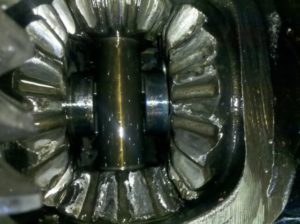 There are various situations which can create rear differential noise. For example, howling of gears is a sure sign of wearing. If you notice that the howling noise only occurs during deceleration, then it is a good indicator that the pinion-bearing preload has loosened.
There are various situations which can create rear differential noise. For example, howling of gears is a sure sign of wearing. If you notice that the howling noise only occurs during deceleration, then it is a good indicator that the pinion-bearing preload has loosened.
Howling under acceleration at various speeds, however, indicates that the gears are already worn out or are out of alignment or depth with each other. If rear differential noise occurs while accelerating the car only at a certain speed, it is likely because the gears have become worn due to overloading and lubrication failure. If your gears are newly installed and still create a howling noise, double-check its preload and make sure that the teeth are properly aligned.
Rumbling and whirring noises at speed over 20 mph, moreover, can be the result of worn carrier bearings. For vehicles with C-clip axles, the rear differential noise may change at different turns. Generally, worn out pinion bearings can create whirring noises at various speeds, be it may during deceleration and/or acceleration. If the pinion bearings are the problem, they create more of a whirring noise than a rumble because it turns several times faster than the carrier assembly. Regular clunking every few feet can also be an indicator of a broken pinion gear and/or chipped and damaged ring gear.
Overly worn out bearings tend to make a howling noise when they do not properly support the gears. Rumbling while turning, on the other hand, is a sign of bad wheel bearings. Clunking and banging noises on the corners can be due to lack of sufficient posi-traction lubrication, broken spider gears, or worn posi-traction or limited-slip clutches. Broken spider gears, moreover, can also immobilize the differential and create a loud, crunching sound during final departure. If the rear differential noise is characterized by clunking every two or three feet, then there is a great chance that a broken ring gear is the problem with the section with the broken teeth banging or grinding as it tries to engage the pinion.
Having a chipped or missing high spot on a gear tooth sounds closely similar to a broken gear except that the rear differential noise only happens while accelerating or decelerating. This is because the problem is just present on one side of the offending tooth. This rear differential noise is described as a heavy clicking type of sound which occurs every eight feet or so. If the pinion is the one that has a high spot, the noise occurs every two or three feet and is much more pronounced because of its higher frequency.
What causes a rear differential to go bad?
Rear differentials ca go bad very fast if they are abused and/or neglected and this can happen even in the first miles of a brand new vehicle.
Here is a list of what can cause a rear differential to go bad:
- Not driving adequately in the break-in period: When a vehicle is brand new, there's a period of 3,000-5,000 miles where certain thresholds should not be crossed if the user does not want to shorten the life of the differential.
In this period only short trips should be made with speeds under 50mph. The pedal should be kept under half-throttle at all times and absolutely no towing or hauling.
All these efforts are essential in order to keep the differential from reaching a high temperature that causes rapid lubrication break-down - Not changing the first gear lube between 3,000-5,000 miles: This interval is used by most axle manufacturers to mark the end of the break-in period. Oil should be changed and the differential magnet cleaned and inspected carefully to make sure all iron particles have been collected and that the magnet is clean enough to continue collecting these hard iron particles.
Depending on the quality of the lube you have in your differential from the start, you might have to lean towards one or another end of this interval. High performance synthetic hear oils can be changed at around 4,500-5,000 miles while lesser oils need to be changed faster. How to know the quality of the oil you're running? Just ask for the ASTM test performance data of your oils producer. - Allowing wheel spin:This is a big one as excessive wheel speed can heat up the differential in short time. Coupling wheel spin up with intermittent good-poor traction creates a deadly cocktail. Intermittent traction like this can be experienced on sand patches on dry roads/ snow or ice and it causes high energy shock loads when grip is suddenly back. This spike in load can cause damage or fracture internal parts of the differential or drivetrain components like universal joints.
- Not checking the breather fitting and breather tube regularly:Checking for leaks, splits or cracks should be done regularly as these can allow either gradual water intrusion from weather or sudden water intrusion from flooded roads or boat ramps. What happens when the hot differential meets cool water is that a vacuum phenomenon appears that rapidly sucks air or water inside. Gear oils can handle air but just a few on the market can handle water contamination and still provide adequate lubrication. Essentially gear oils break down when water is added into the mixture.
- Not upgrading the differential cover: The differential cover should also be upgraded when torque or horsepower is upgraded as well as when towing a heavy trailer is on the list or towing in steep conditions or when you know towing will become regular. Reason behind it is that aftermarket differential covers add more cooling and rigidity that keeps the differential away from flexing under high torque loads and some even allow you to put a sensor inside in order to track temperature from your dashboard.
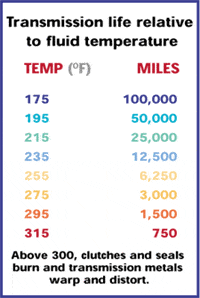 Main thumbnail tip is to always be careful not to induce big shocks or to heat up the rear differential as either gear teeth or entire segments of the differential can be broken or oil can break down, cause a severe lack of lubrication and totally ruin the assembly.
Main thumbnail tip is to always be careful not to induce big shocks or to heat up the rear differential as either gear teeth or entire segments of the differential can be broken or oil can break down, cause a severe lack of lubrication and totally ruin the assembly.
Lubricant life depends a lot on the temperature it reaches. Tests have shown that towing a trailer at 55 mph on a 3.5% grade can result in temperatures up to 370°F where the lifespan of gear oils is best measured in minutes, not miles.
High shock loads can damage teeth because the gears have only so many teeth and not all come into contact at one given moment. That essentially means that the entire load spike will end up on only 2-3 teeth at a time. Manufacturers did not create these complex assemblies with such loads in mind.
How Much Does it Cost to Replace a Rear Differential?
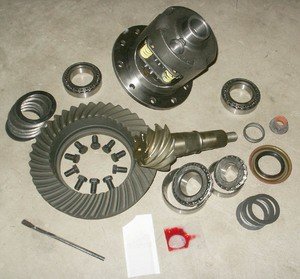 The cost of replacing a rear differential depends on the degree of the repairs that need to be done. Just a few parts to replace will cost significantly less than lots of parts to replace. This could run the bill up from the $200-$400 range to $600-$800.
The cost of replacing a rear differential depends on the degree of the repairs that need to be done. Just a few parts to replace will cost significantly less than lots of parts to replace. This could run the bill up from the $200-$400 range to $600-$800.
Replacing the rear differential entirely costs a whole lot. It depends on the car model and make and also on your preference between salvaged and brand new. You can be looking at anything between $500-$1000 for a salvaged differential with labor included, upwards to $2000-$2500 for a brand new one.
Thankfully it is rather hard to damage the differential so badly that only a total replacement would fix it. Reason for these prices lays in the complexity and sheer number of components ( multiple oil seals, bearings, pinions and shafts) that come together to form this ingenious mechanism.
Fixing Rear Differential Noise
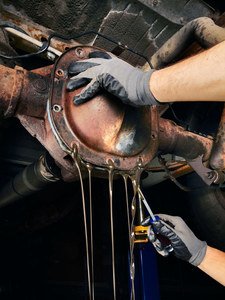 Rear differential noise, when ignored, can lead to major problems and permanent damage on the ring and pinion. Repair of the differential is usually recommended to be left in the hands of professionals because of the complexity of the system.
Rear differential noise, when ignored, can lead to major problems and permanent damage on the ring and pinion. Repair of the differential is usually recommended to be left in the hands of professionals because of the complexity of the system.
Instead, what you could do is to boost up the lubrication on the differential instead. Providing proper lubrication levels will also lessen heat and friction and make the movements of gears against each other much smoother and quieter. This is merely a preventive step, however, and a replacement of the entire mechanism is still recommended for those who have been delayed in fixing the problem.
In terms of lubricants, one very good example is Boost Performance Product's CleanBoost® EMT™ Engine and Metal Treatment. This product is formulated with stabilizing anti-oxidants and special metal deactivators that ensures the smooth performance of the engine and gear applications. When applied, the gear oil in the differential carries this Engine and Metal Treatment to the asperities of the metals to form a covalent, galvanic bond on it. It provides 2 to 4 micron penetration into the surface, therefore lessening heat and friction and quieting rear differential noise where applicable.
For more information about this product, simply head here.
What Happens When Your Rear Differential Goes Out?
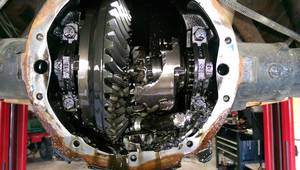 Before a rear differential goes out, it starts to give you hints in form of sounds or even leaks. It would be best to not leave these signs ignored as each extra mile done under these circumstances might increase your repair bill in the future.
Before a rear differential goes out, it starts to give you hints in form of sounds or even leaks. It would be best to not leave these signs ignored as each extra mile done under these circumstances might increase your repair bill in the future.
Differentials are complex mechanical elements and changing a gasket or pinion seal comes with a significantly lower cost than having to rebuild the entire differential or swap it out completely. When issues start to occur, a howling sound might appear from the rear of your truck while driving. It can be continuous, come and go or even change pitch as it all depends on the load on the differential as well as the severity of the issue.
Another symptom you could experience while the differential is giving out is that the car can start to shake or vibrate. Depending on the severity, vibration can become more noticeable as you reach higher speeds or if it's very severe, you might experience heavy vibrations under acceleration from a stop. Leaks are also on this list and would represent the cheapest repair depending on how low the oil level got in the differential.
If for some reason these symptoms go undetected and the differential goes out completely it can put your life in serious danger, depending on the context. Your car can either stop putting power down to the wheels or have the differential lock up completely. Both these scenarios can potentially make you loose control of the car depending on the speed you are traveling at and road conditions.
2003 Dodge Dakota Rear End Noise When Backing
Source: https://fuelandfriction.com/weekend-warrior/understanding-rear-differential-noise/
0 Response to "2003 Dodge Dakota Rear End Noise When Backing"
Post a Comment